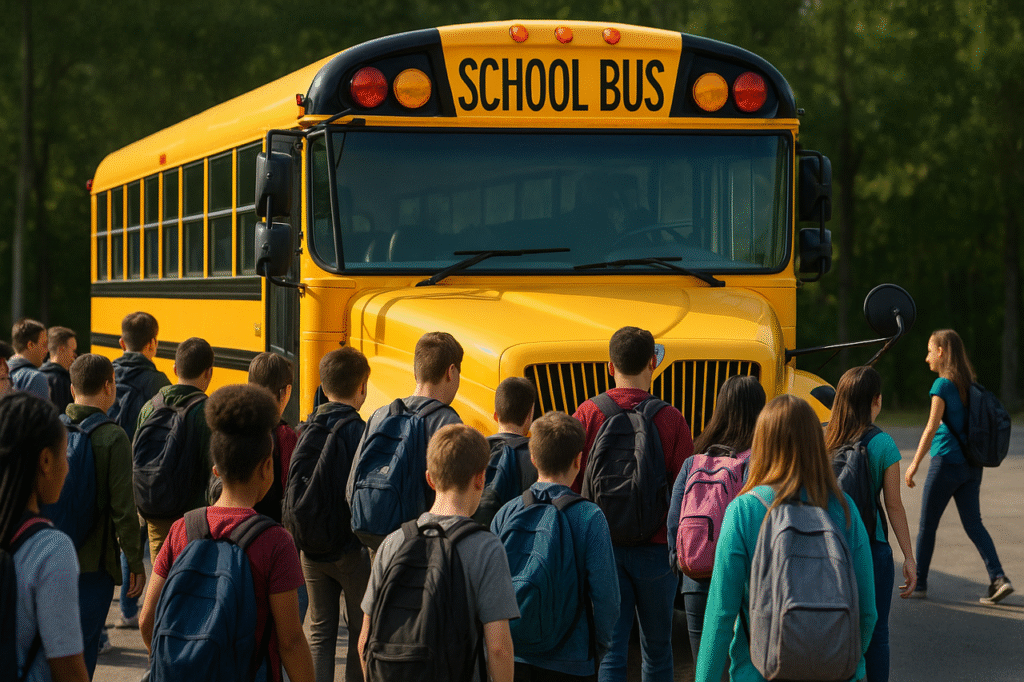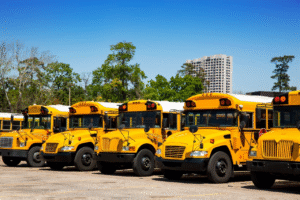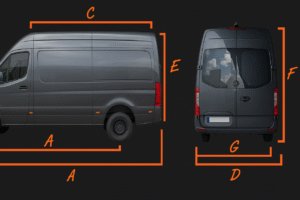When planning transportation for a large group, knowing how many seats are on a school bus can help you choose the right vehicle. Whether you’re organizing a field trip, sports event, or shuttle service, understanding bus sizes ensures comfort, safety, and efficiency for your group.
Standard School Bus Seating Capacities
School buses with different seating capacities come in various sizes and configurations. Here’s a quick breakdown:
1. Small School Bus (Type A)
The Small School Bus (Type A) is a compact and versatile option, typically seating between 10 to 30 passengers. Designed with maneuverability and safety in mind, this bus is ideal for short-distance travel, field trips, daycare centers, or transporting small groups of students, especially those with special needs. Its smaller size allows for easier navigation through narrow streets and tight parking areas, making it a smart choice for schools or organizations that don’t require a full-sized fleet.
2. Mid-Size School Bus (Type B/C)
The Mid-Size School Bus (Type B/C) offers a comfortable seating capacity for 30 to 48 passengers, making it a popular choice for schools and youth programs that need a bit more space than a minibus but don’t require a full-sized option. These buses are perfect for field trips, after-school programs, and sports team transportation, providing ample room for students, gear, and chaperones.
3. Full-Size School Bus (Type D)
The Full-Size School Bus (Type D) is the classic yellow icon most people picture when they think of school transportation. With a seating capacity of up to 72 children or 48 adults, this bus is built to handle large groups and long-distance trips with ease. It’s the go-to option for schools needing to transport full classes, multiple grades, or athletic teams across town, or even to another city.
Some of the Warning Signs That Your Bus Capacity Is Unsafe

Even if a bus seems full but manageable, exceeding or improperly using its capacity can be dangerous. Here are a few warning signs that your bus may be over capacity or operating unsafely:
1. Passengers Standing or Sitting in Aisles
School buses are designed with specific seating limits. If students or adults are standing, sitting on the floor, or crowding the aisles, it’s a clear red flag. This not only violates safety regulations but also puts everyone at higher risk in case of sudden stops or accidents.
2. Overcrowded Seats
Most bench seats are made to fit two adults or three children. If more people are squeezed in, comfort is compromised, and so is safety. Overcrowding can prevent passengers from sitting properly, increasing the risk of injury during abrupt stops. It also makes it harder for the driver to monitor student behavior and maintain control of the bus environment.
3. Difficulty in Evacuation Drills
An overcrowded bus may fail to meet emergency evacuation time standards. If it’s hard for everyone to exit quickly, you may need a larger bus or a second vehicle. Delays in evacuation can pose serious risks during emergencies like fires or accidents, especially when aisles are blocked or exits are hard to access.
4. Driver Complaints or Concerns
Bus drivers are often the first to notice unsafe conditions. If your driver is expressing concerns about capacity, take it seriously and reevaluate the seating plan. Drivers may also report behavioral issues or difficulty navigating tight, overcrowded spaces, all of which can impact the overall safety and efficiency of the route.
Need More Than a School Bus? Ride Smarter with Brilliant Charters
Traditional school buses seat 48-72 kids, but they lack modern comforts. For AC, reclining seats, and extra space, Brilliant Charters has you covered! While we don’t offer traditional school buses, we specialize in modern, spacious charter buses that are ideal for school districts, private events, and group travel of all kinds.
Our buses are designed for comfort, think reclining seats, air conditioning, and extra legroom, making them a great choice for longer journeys where comfort matters most.








